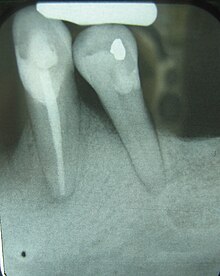| Occlusal trauma | |
|---|---|
 | |
| Secondary occlusal trauma on X-ray film displays two lone-standing mandibular teeth, the lower left first premolar and canine. As the remnants of a once full complement of 16 lower teeth, these two teeth have been alone in opposing the forces associated with mastication for some time, as can be evidenced by the widened PDL surrounding the premolar. Because this trauma is occurring on teeth that have 30-50% bone loss, this would be classified as secondary. | |
| Specialty | Dentistry, ENT surgery |
Occlusal trauma is the damage to teeth when an excessive force is acted upon them and they do not align properly.[1]
When the jaws close, for instance during chewing or at rest, the relationship between the opposing teeth is referred to as occlusion. When trauma, disease or dental treatment alters occlusion by changing the biting surface of any of the teeth, the teeth will come together differently, and their occlusion will change.[2] When that change has a negative effect on how the teeth occlude, this may cause tenderness, pain, and damage to or movement of the teeth. This is called traumatic occlusion.[1][3]
Traumatic occlusion may cause a thickening of the cervical margin of the alveolar bone[4] and widening of the periodontal ligament, although the latter can also be caused by other processes.[5]
- ^ a b Bibb, CA: Occlusal Evaluation and Therapy in the Management of Periodontal Disease. In Newman, MG; Takei, HH; Carranza, FA; editors: Carranza’s Clinical Periodontology, 9th Edition. Philadelphia: W.B. Saunders Company, 2002. pages 698-701.
- ^ Hinrichs, JE: Occlusal The Role of Dental Calculus and Other Predisposing Factors. In Newman, MG; Takei, HH; Carranza, FA; editors: Carranza’s Clinical Periodontology, 9th Edition. Philadelphia: W.B. Saunders Company, 2002. page 192.
- ^ traumatogenic occlusion - definition of traumatogenic occlusion in the Medical dictionary - by the Free Online Medical Dictionary, Thesaurus and Encyclopedia
- ^ Carranza, FA: Bone Loss and Patterns of Bone Destructions. In Newman, MG; Takei, HH; Carranza, FA; editors: Carranza’s Clinical Periodontology, 9th Edition. Philadelphia: W.B. Saunders Company, 2002. page 362.
- ^ Trauma from Occlusion Handout, Dr. Michael Deasy, Department of Periodontics, NJDS 2007. page 5